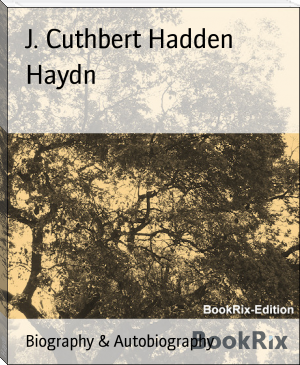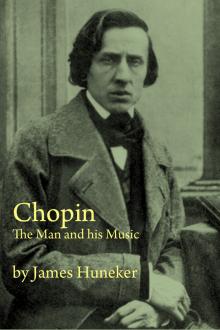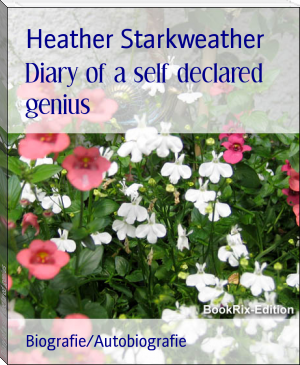Haydn, J. Cuthbert Hadden [books for new readers .TXT] 📗

- Author: J. Cuthbert Hadden
Book online «Haydn, J. Cuthbert Hadden [books for new readers .TXT] 📗». Author J. Cuthbert Hadden
Failing Strength--Last Works--A Scottish Admirer--Song Accompaniments--Correspondence with George Thomson--Mrs Jordan-- A Hitch--A "Previous" Letter of Condolence--Eventide--Last Public Appearance--The End--Funeral Honours--Desecration of Remains.
Failing Strength
Little is left to be told of the years which followed the production of "The Seasons." Haydn never really recovered from the strain which that last great effort of his genius had entailed. From his letters and the reminiscences of his friends we can read only too plainly the story of his growing infirmity. Even in 1799 he spoke of the diminution of his mental powers, and exclaimed: "Oh, God! how much yet remains to be done in this splendid art, even by a man like myself!" In 1802 he wrote of himself as "a gradually decaying veteran," enjoying only the feeble health which is "the inseparable companion of a gray-haired man of seventy." In December 1803 he made his last public exertion by conducting the "Seven Words" for the hospital fund at the Redoutensaal, and shortly afterwards wrote sadly of his "very great weakness." In 1804 he was asked to direct a performance of "The Creation," but declined on the score of failing strength. Gradually he withdrew himself almost entirely from the outside world, his general languor broken only by the visits of friends and by moods of passing cheerfulness. Cherubini, the Abbe Vogler, Pleyel, the Weber family, Hummel, Reichardt, and many others came to see him. Visits from members of the Esterhazy family gave him much pleasure. Mozart's widow also brought her son Wolfgang, to beg his blessing on the occasion of his first public concert in April 1805, for which he had composed a cantata in honour of Haydn's seventy-third birthday. But the homage of friends and admirers could not strengthen the weak hands or confirm the feeble knees. In 1806 Dies notes that his once-gleaming eye has become dull and heavy and his complexion sallow, while he suffers from "headache, deafness, forgetfulness and other pains." His old gaiety has completely gone, and even his friends have become a bore to him. "My remaining days," he said to Dies, "must all be spent in this lonely fashion.... I have many visitors, but it confuses me so much to talk to them that at last I scarcely know what I am saying and only long to be left in peace." The condition of a man of naturally genial and optimistic temperament can easily be imagined from all this--perhaps even more from the fact of his having a card printed to hand to inquirers who called, bearing the words:
Hin ist alle meine Kraft; Alt and schwach bin ich.
[Fled for ever is my strength; Old and weak am I.]
Last Works
But while Haydn was thus suffering from the natural disabilities of his years, he was not wholly divorced from his art. It is true that nothing of any real importance came from his pen after "The Seasons," but a good deal of work of various kinds was done, some of which it is impossible for the biographer to ignore. One rather novel undertaking carries us back to the end of 1799, about which time he was first asked by George Thomson, the friend of Burns, to write accompaniments for certain Scottish songs to be published in Thomson's well-known national collections. The correspondence which followed is interesting in many ways, and as it is not noticed in any other biography of Haydn, we propose to deal with it here. [The letters passed through the present writer's hands some five years ago, when he was preparing his Life of George Thomson(1898). They are now in the British Museum with the other Thomson correspondence.]
A Scottish Admirer
George Thomson engaged at one time or other the services of Beethoven, Pleyel, Weber, Hummel, Bishop and Kozeluch. But Haydn was his first love. A genius of the kind, he writes in 1811 "never before existed and probably never will be surpassed." He is "the inimitable Haydn," the "delectable," the "father of us all," and so on. On the other hand, Haydn was proud of what he did for Thomson. "I boast of this work," he said, "and by it I flatter myself my name will live in Scotland many years after my death." Nay, if we may trust an authority cited by Thomson, so highly did he think of "the symphonies and accompaniments which he composed for my melodies as to have the original score of each framed and hung all over the walls of his bedroom." Little wonder that Thomson "loved the dear old man" and regretted that his worldly circumstances did not allow him to erect a statue to the composer at his own expense!
We have called this writing of symphonies and accompaniments for George Thomson a novel undertaking. It was, however, only novel in the sense of being rather out of Haydn's special "line." He had already been employed on work of the kind for the collection of William Napier, to which he contributed the accompaniments of 150 songs. Later on, too (in 1802-1803), he harmonized and wrote accompaniments for sixty-five airs, for which he received 500 florins from Whyte of Edinburgh. The extent of his labours for George Thomson we shall now proceed to show.
Song Accompaniments
Thomson addressed his first letter to Haydn in October 1799. There is no copy of it, but there is a copy of a letter to Mr Straton, a friend of Thomson's, who was at this time Secretary to the Legation at Vienna. Straton was to deliver the letter to Haydn, and negotiate with him on Thomson's behalf. He was authorized to "say whatever you conceive is likely to produce compliance," and if necessary to "offer a few more ducats for each air." The only stipulation was that Haydn "must not speak of what he gets." Thomson does not expect that he will do the accompaniments better than Kozeluch--"that is scarcely possible"(!); but in the symphonies he will be "great and original." Thomson, as we now learn from Straton, had offered 2 ducats for each air (say 20s.); Haydn "seemed desirous of having rather more than 2 ducats, but did not precisely insist upon the point." Apparently he did not insist, for the next intimation of the correspondence is to the effect that thirty-two airs which he had just finished had been forwarded to Thomson on June 19, 1800. They would have been done sooner, says Straton, but "poor Haydn laboured under so severe an illness during the course of this spring that we were not altogether devoid of alarm in regard to his recovery." Thomson, thus encouraged, sent sixteen more airs; and Straton writes (April 30, 1801) that Haydn at first refused to touch them because the price paid was too low. But in the course of conversation Straton learnt that Haydn was writing to Thomson to ask him to procure a dozen India handkerchiefs, and it struck him that "your making him a present of them might mollify the veteran into compliance respecting the sixteen airs." Straton therefore took upon himself to promise in Thomson's name that the handkerchiefs would be forthcoming, and "this had the desired effect to such a degree that Haydn immediately put the sixteen airs in his pocket, and is to compose the accompaniments as soon as possible on the same terms as the former."
Mrs Jordan
The handkerchiefs duly arrived--"nice and large"--and Haydn made his acknowledgments in appropriate terms. At the same time (in January 1802) he wrote: "I send you with this the favourite air 'The Blue Bells of Scotland,' and I should like that this little air should be engraved all alone and dedicated in my name as a little complimentary gift to the renowned Mrs Jordan, whom, without having the honour of knowing, I esteem extremely for her great virtue and reputation." Mrs Jordan has been credited with the air of "The Blue Bells of Scotland." She certainly popularized the song, whether it was her own or not. In the note just quoted Haydn must have used the term "virtue" in the Italian sense.
A Hitch
After this a little hitch occurred in the Thomson correspondence. Haydn, being asked by Whyte, the publisher of a rival collection, to do something for his work, at once agreed. Thomson, not unnaturally, perhaps, felt hurt. He made his complaint through Mr Straton's successor at the Embassy, Mr Charles Stuart; and in August 1803 Stuart writes to say that he had broached the matter to Haydn "in as delicate terms as possible for fear he might take offence." Haydn frankly admitted that he had done the accompaniments for Whyte, but said the airs were different from those he had done for Thomson. After "a long conversation, he informed me," says Mr Stuart, "that being now seventy-four years of age and extremely infirm, he found himself wholly incapable of further application to study; that he must therefore beg leave to decline all offers, whether on your part or from any other person whatsoever. He even declared that notwithstanding the repeated requests of Prince Esterhazy, he felt himself utterly incapable of finishing several pieces of music he had undertaken, and being possessed of a competency he desired nothing so much as to pass the short time he has yet to live in repose and quiet." From this letter we learn that Thomson had unluckily sent a present of a handkerchief for Frau Haydn, who had now been dead for three years!
A "Previous" Letter of Condolence
In spite of the little misunderstanding just referred to Haydn was brought round once more, and on the 20th of December 1803 Thomson sends twenty-four airs, "which will most certainly be the last." Haydn's work delights him so much that he "really cannot bear the idea of seeking an inferior composer to finish a work already so nearly finished by you." He would pay 4 ducats for each air rather than have the mortification of a refusal. After this there is little of interest to note in the correspondence, unless it be a very "previous" letter of condolence which Thomson sent to Vienna. A false rumour had reached him that Haydn was dead. The following extract from a note which Haydn dictated to be sent to the friend who received Thomson's letter will explain the matter:
Kindly say to Mr Thomson that Haydn is very sensible of the distress that the news of his alleged death has caused him, and that this sign of affection has added, if that were possible, to the esteem and friendship he will always entertain for Mr Thomson. You will notice that he has put his name and the date on the sheet of music to give better proof that he is still on this nether world. He begs you at the same time to be kind enough to have Mr Thomson's letter of condolence copied and to send him the copy.
Haydn's experience in this way was perhaps unique. Burney says he was reported dead in 1778; and the false rumour which reached Thomson in 1805 led Cherubini to compose a sacred cantata for three voices and orchestra, which was duly performed in Paris when his death actually occurred.
Haydn furnished in all some 250 airs with symphonies and accompaniments for Thomson. In the packet of letters from the composer, docketed by Thomson himself, the latter has placed a slip of paper indicating the various payments he had made. According to this statement Haydn had 291 pounds, 18s. for his work from first to last--not by any means an insignificant sum to make out of a side branch of his art.
Eventide
This interesting correspondence takes us up to the year 1806, by





Comments (0)